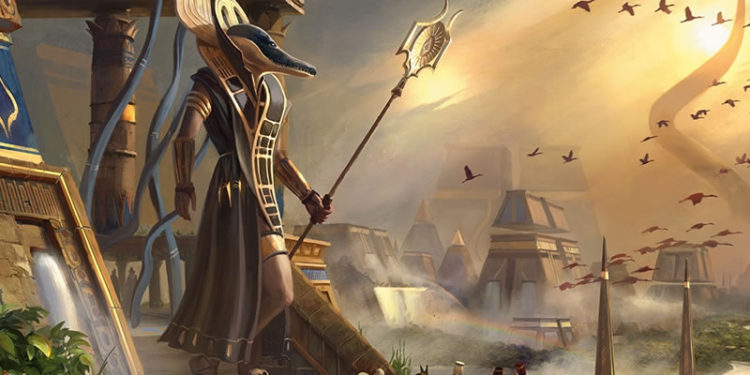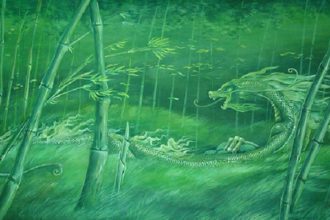Plane Shift: Amonkhet Breakdown

James Wyatt recently released the fourth conversion of a Magic: the Gathering setting to D&D 5e. Amonkhet is an Egyptian-inspired dark fantasy setting, which James describes in the Introduction as “outside the core D&D experience,” but I’m not completely sure why – other than being a pastiche of a place that isn’t Europe or Asia, even the elevator pitch is dense with D&D-friendly adventure hooks. Amonkhet is also built upon a dark secret – well, secret from the characters at least. Nicol Bolas’s secret control of the whole plane is advertised throughout the document, and players would have a hard time missing it. Anyway, the document is crammed with usable content, so let’s dive in.
Backgrounds
First up, we have three new Backgrounds, relating to the results of your character’s Ceremony of Measurement. You might be an Initiate, working toward being a glorious human sacrifice to the God-Pharaoh; a Vizier, one of the priesthood and the facilitators for Initiates on that path; or a Dissenter, a rebel against that social structure. You can even start as one of the first two and become a Dissenter in the course of play.
More so than most D&D games, the Backgrounds of party members shape the story and conflicts of the game. Completing the Trials of the Five Gods (which inevitably end in your demise) is one of the suggested campaign frames, especially for shorter campaigns. Even one Dissenter PC in a group mostly made up of Initiates and Viziers is going to create a hugely different experience.
The Initiate and the Vizier backgrounds both offer a full slate of personality features, while the Dissenter does not – but it takes next to nothing to derive them, with negations of many of the Initiate or Vizier features. I assume that a lot of Dissenter PCs started as an Initiate or Vizier, only dissenting once they learned the awful truth.
Initiates receive proficiency in Athletics, Intimidation, one gaming set, and land vehicles (presumably so they can drive chariots in the greatest sword-and-sandal style). Their starting equipment is fairly normal, though one doesn’t have to stretch too far to spark a lot of adventure off of “a simple puzzle box” that, one day, isn’t empty. Five of their six Ideals are the virtues of the setting’s five gods, so that’s on-message; the sixth is about expiating the sin of doubt.
The Initiate’s feature is interesting in that it establishes a lot of your default surroundings. Much as large portions of Hunger Games and Catching Fire take place in the training facilities, Initiates probably spend all of their time between adventures in the dormitories or whatever that are set aside for Initiates. (Protip: if you’re DMing an Amonkhet campaign, be prepared for a ton of Hunger Games jokes.)
The Vizier gains proficiency in History, Religion, one type of artisan’s tools, and one musical instrument. Their starting gear is even more straightforward, while their feature is about establishing their position in society – superior to the Initiates. Make sure everyone in the group knows what they’re getting into before you commit to this! Not everyone is going to be okay deferring to another PC, or taking orders. This is a lot like playing Effie Trinket, Caesar Flickerman, and so on up the hierarchy. Since the viziers serve the gods directly – a priesthood composed of any character class – the Vizier’s personality features are labeled with the gods they fit best. Interestingly, the flaws of both Initiates and Viziers are written to lead them into rebellion against this corrupt social order – the life of the Dissenter.
Races
The document includes five races, which is the least surprising of all numbers for a Magic: the Gathering setting. Humans are one of them, and all I need to say here is that Amonkhet goes with the Variant Human.
Next up are the aven, who look like humans with wings and the heads of either ibises or hawks, depending on their subrace. For a lot of DMs, including me, a race with a fly speed is a big problem for encounter design, whether we’re talking about combat or environmental challenges. Accordingly, I am no fan of aarakocra or aven. Still, let’s look at the whole package: +2 Dex, paired with either +1 Int or +2 Wis (this is not a misprint). Their walking speed is 25 feet, an unexpected – if seldom relevant – drawback, and they have a fly speed of 30 feet while they are not encumbered or wearing medium or heavy armor. I’m just gonna suggest that not a lot of +2 Dex races are super worried about wearing medium or heavy armor.
The ibis-headed aven – the +1 Int ones – also gain half their proficiency bonus to any Int check they aren’t otherwise proficient in, which is pretty nice. Admittedly, this has the odd effect of discouraging them from picking up proficiency in the skills most associated with their subrace. The hawk-headed aven – the +2 Wis ones – gain proficiency in Perception, and don’t suffer disadvantage on ranged attacks against creatures at long range.
The jackal-headed khenra call to mind the jackal-headed sibeccai of Monte Cook’s Arcana Evolved, but their racial story and features turn in a different direction. They gain +2 Dex and +1 Strength, with no subraces. A base move speed of 35 feet is quite nice, as is a collection of weapon proficiencies… though none of those weapons use that tasty Dex bonus. Also, proficiency in two specific simple weapons only barely qualifies as a feature, since the great majority of classes automatically gain simple weapon proficiency. Finally, khenra are nearly always born as twins. In the presence of their twin, khenra can reroll any 1 they roll for an attack, save, or check. If their twin is dead, they instead gain immunity to the frightened condition. A khenra with a twin that is a living NPC and not part of the party mostly won’t get to use their central feature. The rest of the race is straightforward and a little clashing on its ability score priorities. Overall, the khenra are underwhelming, unless they’re the sole surviving twin – in which case they have an immunity to a common effect and, as you likely expect, I oppose that on principle.
Minotaurs are half-orcs, but with horns that use a d6 damage die instead of 60-ft darkvision. That feels like a real path of least resistance design, and I’m kinda disappointed. If nothing else, their racial abilities are so focused on supporting melee combat that the flavor text attached to them seems improbable.
Nagas are the last PC race here, though these nagas come with arms and a generally more humanoid upper body than standard D&D nagas. They don’t have subrace divisions, but get +2 Con and +1 Int. While their hands are empty, they can spend a bonus action to increase their movement speed by 5 feet. This feature is badly flawed, because more than a few classes can expect to Dash as a bonus action. Given its requirement of empty hands, it should either not cost a bonus action, or should also intrinsically be a Dash action.
On the other hand, their natural weaponry – fangs – are hilariously overpowered if you’re a monk, since they toss out an extra d4 poison damage on a failed Con save, and otherwise scale with your monk damage. Forcing a Con save with every hit would get old in a hurry, I have to say. They further have a damaging Constrict attack that can replace their natural weapon attacks (again, super monk-friendly), which both deals d6 + Str damage and causes the target to be grappled on a hit, with nonstandard rules to escape a PC grappling an opponent. This grapple inherently restraints the target. There’s no discussion of whether you can keep making constrict attacks against a target you’re already grappling, just a note that you can’t constrict multiple targets at a time. This feature is messy and probably way too good. Finally, naga are also immune to poison damage and the poisoned condition (hiss, and also boo), and have proficiency in the poisoner’s kit.
So yeah, I’m not a fan of really any part of the naga racial features. Some features are too weak to really get used, others are insanely good, there’s immunity to a common condition and damage type… it’s problems all the way down, as far as I’m concerned. It also pushes you so hard to play a monk that I’m not really sure what’s going on in the race’s thematic text. The text indirectly suggests that you could pair this with rogue (the bit about daggers and shortswords), but it’s astoundingly bad at that because rogues can’t Sneak Attack with those natural weapons.
New Domains
The God-Pharaoh left five gods in charge of Amonkhet during his absence, and each of those gods offers one domain. Four of these are new or new-ish domains, while the fifth uses the Knowledge domain as printed.
First up, we have the Solidarity domain, which takes the already very leader-ish cleric (in the 4e sense of “leader”) and makes it a lot more so by bolting on warlord-flavored features. Their domain spells are pure support, with a lot of area effects centered on the caster at the higher levels. Heavy armor proficiency is no big surprise. They take a page from the SCAG Mastermind’s feature to Help an ally as a bonus action, but flip it: when you Help an ally as an action, you can attack as a bonus action. This is limited to uses equal to your Wisdom modifier per long rest, taking a page from the War domain’s War Priest feature. The one knock-on effect I see from this is that anything that cares about “when you use the Attack action” isn’t triggered.
From here, it starts to look like a Greatest Hits of other domains – Preserve Life at 2nd level (from the Life domain), Olektra’s Blessing at 6th level (War God’s Blessing, from the War domain), Divine Strike at 8th (from the great majority of domains), and Supreme Healing at 17th (again from the Life domain). This is pretty well a blend of Life and War, which is no big surprise for M:tG’s White magic.
The Strength domain, then, can still lift a few more things from War, but since it’s M:tG Green-based, it pulls in features from Nature and Tempest as well. This starts to show itself in the domain spells, but really we’re looking at Acolyte of Strength at 1st level (Acolyte of Nature) and proficiency with heavy armor (both Nature and War) – and I have to say, getting nothing but proficiencies as your 1st-level features means you don’t feel distinct within your subclass yet. Feat of Strength and Rhonas’s Blessing, their 2nd-level and 6th-level Channel Divinity options, are like Guided Strike and War God’s Blessing, but can also apply to Strength checks or saves. Divine Strike and Avatar of Battle are the same as the War domain. So it’s a very light dip into anything but the War domain, and otherwise is like the War domain but a little bit broader in application. Loss of the War Priest feature stings, though.
Continuing in the pattern, Ambition is a blend of Light and Trickery. The domain spells are a bit of a mixed bag, lifting from Trickery and the general cleric list. Warding Flare at 1st is the key Light feature, while Invoke Duplicity, Cloak of Shadows, Divine Strike, and Improved Duplicity are Trickery right down the line.
Finally, Zeal: the last little unused bit of War, some Tempest features, and a new features that I don’t recognize from anything else, but would fit into a putative Fire or Wrath domain. The domain spells are fiery and mostly melee-friendly. The bonus proficiencies include heavy armor and all martial weapons, which the other War-linked domains have left out. Priest of Zeal is a rename of the War Priest feature, which is quite potent if you’ve gone all in on a high-damage martial weapon (and if you didn’t, why did you pick War/Zeal?). Their 2nd-level Channel option is Consuming Fervor, which does for fire and thunder what Destructive Wrath (Tempest 2) does for lightning and thunder. Resounding Strike is like Thunderbolt Strike, but for thunder rather than lightning damage. Divine Strike shows up at 8th level, of course.
Their final feature, at 17th level, is Blaze of Glory. When you’re reduced to 0 hit points, even if you’re instantly killed, you can use your reaction to murder someone right in the face, moving and making a melee weapon attack with advantage that deals 5d10 fire damage and 5d10 damage of your weapon’s flavor. That is pretty frickin’ convincing, but to be fair, if you’re the party’s healer, they have a super bad time if you’re about to die, so let’s hope that that 10d10 damage does the job. Don’t miss. This feature is once per long rest, of course. We saw a number of on-death effects from UA articles – a bunch all together, I seem to recall – but I don’t recall this one specifically, so it’s cool to see it here. I’m curious about whether your Concentration effects, like this domain’s Zeal effects, kick in before you take that swing. It’s obvious to me that the satisfying answer is no, but I’m less sure about the technical answer.
And that’s it for domains. I have to keep reminding myself that this document is aiming for the easy implementation that gets the job done, rather than providing exciting new content for broader use. It’s easy to feel disappointed with the heavy reuse of features in these domains, since we’ve gotten used to seeing Plane Shifts as a secondary form of Unearthed Arcana content, but it’s sensible given the goal of this whole project. Solidarity is probably a little too good, Strength is good but I’m not sure it’s fun early on, Ambition’s Warding Flare feature is a clear upgrade on Trickery’s Blessing of the Trickster (which is good, Trickery is not so well regarded in terms of power level), and Zeal is my favorite of the bunch for being the most different.
New Monsters
For the most part, this section talks about which creature stats to substitute in for Amonkhet’s many monsters and horrors, which is useful advice in any case. And man, angels are awful in this setting, in both the current and archaic sense of the word. I hereby give this flavor text the Rainer Maria Rilke stamp of approval. That’s a thing I am obviously qualified to do, by virtue of my BA in English. (Rilke wrote in German.)
Look, if you thought I was going to get through this without bizarre digressions, you came to the wrong place, friend.
Anyway, the new monsters are the criosphinx, which is roughly like the sphinxes of the Monster Manual but set at CR 13; the heart-piercer manticore, which is wingless and has a scorpion tail rather than projectile spikes, at CR 5 (I like this a lot, especially the art); and the serpopard, a more serpentine great cat, at CR 3. Because what leopards needed was a venomous bite! Anyway, these are all fine and good for stealing, especially if you’re a traditionalist and you’ve been wondering why the criosphinx isn’t in the Monster Manual already.
Advice
The last page-or-so of the document steps back to consider the whole Plane Shift series and offer guidance on how to use them all together to present an interplanar campaign for starting PCs, even PCs who are M:tG-style Planeswalkers. The advice here is generally good, though it could use more pointers on how to threaten or interest PCs who can always go be somewhere else instead. Wyatt’s commentary on that point begins and ends with “get everyone to agree ahead of time,” which is a good start but ignores emergent, in-character motivation and letting players really engage with near-total cosmic freedom. Broadly, the better answer is, “Go read Zelazny, and then go read Erick Wujcik writing about how to run Zelazny.”
You know what? Don’t wait until you decide to run a Planeswalker campaign to do that. I don’t care who you are, you probably have something left to learn about GMing from Erick Wujcik.
Overall, I am super interested in the Amonkhet setting, though I am not fully sold on some of the mechanical choices here. The best things about the document are the Hunger Games backgrounds and the new monsters. At the other end, the naga and maybe the aven could use another pass, and I’d like to see the racial features match the flavor text on all of the races a bit better. If the flavor text describes a lot of different things that race does well but the racial features selectively favor just one class, there’s a disconnect that is going to cause player dissatisfaction.
In short, I’d run this, either as a single plane or as a planeswalking campaign, but I wouldn’t do so straight out of the box.



